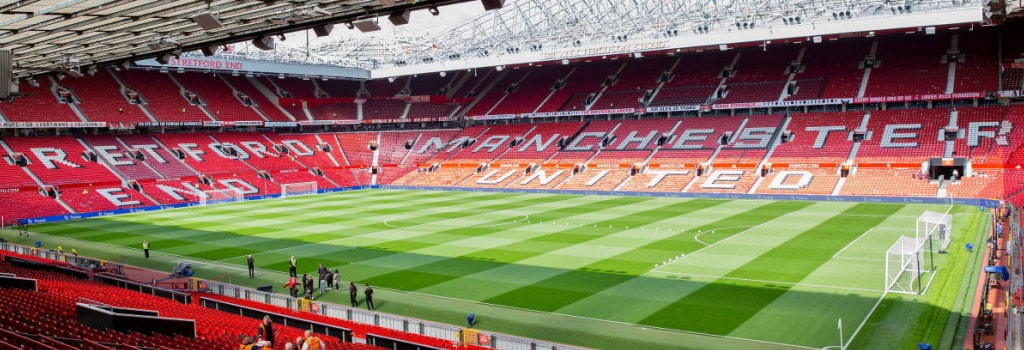

Football holds a unique place in the heart of Europe. With its rich history and die-hard fan base, the game is woven into the fabric of European society. Stadiums, seen as sacred grounds by football enthusiasts, encapsulate the electric atmosphere, the heart-throbbing action, and the unparalleled passion of the fans. Here, we will journey through the 10 most popular football stadiums in Europe, exploring their unique charms, history, and the unforgettable moments they have witnessed.
Camp Nou, the fortress of FC Barcelona, is the largest football stadium in Europe. With a staggering capacity of almost 99,354 spectators, it is a place where magic comes alive. Legends like Messi, Xavi, and Iniesta have graced its stands. In addition, the stadium resonates with "Més que un club" (More than a club), embodying a sense of unity and belongingness that makes every visit unforgettable.
Known as the 'Theatre of Dreams', Old Trafford is the emblem of Manchester United. This stadium, a favorite among fans who bet on soccer, has been home to the Red Devils since 1910 and has staged many iconic football moments. Its aura, coupled with a capacity of over 74,000, makes it a bucket-list destination for football lovers worldwide. The blend of history and modernity encapsulated within its stands breathes life into every match.
With its futuristic architecture and radiant exterior, the Allianz Arena is a gem of Munich. Home to Bayern Munich, it can accommodate 75,000 spectators. Known for its unique diamond exterior that can change color, the stadium embodies the dynamism of modern football while offering an enchanting football experience.
A timeless classic, the Santiago Bernabeu is the heart of Real Madrid. With a capacity of 81,000, the stadium has been witness to some of the greatest chapters in football history. From thrilling El Clasicos to Champions League nights, its aura is simply captivating, making it one of Europe's most cherished football destinations.
With a capacity of 90,000, Wembley Stadium is synonymous with England's football legacy. Its iconic arch is recognizable worldwide and has hosted countless memorable events, from FA Cup finals to Olympic football matches and other sports matches. In addition, the colossal stadium stands as a symbol of unity and sporting spirit.
Anfield, the home of Liverpool FC, is renowned for its electrifying atmosphere. The famous "This is Anfield" sign, and the unique singing of "You'll Never Walk Alone" create an unmatched ambience. With a capacity of over 53,000, Anfield captures the pure essence of football, creating an indelible experience for its visitors.
Best known for the Yellow Wall, Signal Iduna Park is home to Borussia Dortmund. With a capacity of over 81,000, it holds the record for the highest average attendance in Europe. In addition, the stadium is known for its passionate supporters, who create a wall of sound and color that is awe-inspiring.
Also known as San Siro, this iconic stadium in Milan is shared by AC Milan and Inter Milan. The Stadio Giuseppe Meazza, with its distinctive spiral walkways, can accommodate over 80,000 spectators. A testament to Italian football's heritage, it delivers an authentic, passionate match-day experience.
The Parc des Princes is more than just a stadium for Paris Saint-Germain (PSG). It's a symbol of the club's ambition and style. With a capacity of 47,929, this stadium's design is focused on keeping spectators close to the action. It's famous for its electric atmosphere, especially on European nights when the air is thick with anticipation and excitement.
Estadio da Luz, translated as the Stadium of Light, is the home ground of SL Benfica. With a seating capacity of 65,000, it's the largest stadium in Portugal. The stadium is renowned for its stunning architecture and the remarkable ambience created by passionate Benfica fans. It's a vivid symbol of Portugal's love for football and embodies their national spirit in the sport.
Each football stadium in Europe has its unique character, story, and significance that reflect the game's culture, passion, and history. From Anfield's electrifying atmosphere to the Allianz Arena's architectural beauty, these are more than just structures of steel and concrete. They are the heart and soul of the beautiful game in Europe, hosting unforgettable moments and creating lifelong memories for football enthusiasts around the globe. Exploring these iconic stadiums brings us closer to understanding why football is so deeply loved and profoundly influential in this part of the world.
The 91 biggest football stadiums in Europe. From Manchester to Munich, Villa Park to Valencia - each one with a capacity over 40,000
My daughter's first ever football match - Orlando City v Atlanta United, August 2019. Written for Izzy to read when she gets old enough. Vamos Orlando
23 interesting things to do to pass the time until the football season restarts
Taking my son to his first football match was one of the best experiences I've had as a father so far. I've written this article for Alex to read when he gets older.
